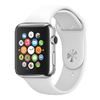Sleep is a fundamental physiological process that is essential for sustaining a healthy body and mind. The gold standard for clinical sleep monitoring is polysomnography(PSG), based on which sleep can be categorized into five stages, including wake/rapid eye movement sleep (REM sleep)/Non-REM sleep 1 (N1)/Non-REM sleep 2 (N2)/Non-REM sleep 3 (N3). However, PSG is expensive, burdensome, and not suitable for daily use. For long-term sleep monitoring, ubiquitous sensing may be a solution. Most recently, cardiac and movement sensing has become popular in classifying three-stage sleep, since both modalities can be easily acquired from research-grade or consumer-grade devices (e.g., Apple Watch). However, how best to fuse the data for the greatest accuracy remains an open question. In this work, we comprehensively studied deep learning (DL)-based advanced fusion techniques consisting of three fusion strategies alongside three fusion methods for three-stage sleep classification based on two publicly available datasets. Experimental results demonstrate important evidence that three-stage sleep can be reliably classified by fusing cardiac/movement sensing modalities, which may potentially become a practical tool to conduct large-scale sleep stage assessment studies or long-term self-tracking on sleep. To accelerate the progression of sleep research in the ubiquitous/wearable computing community, we made this project open source, and the code can be found at: https://github.com/bzhai/Ubi-SleepNet.
翻译:睡眠是一种基本的生理过程,对于保持健康的身体和心灵来说,睡眠是一种基本的生理过程。临床睡眠监测的金质标准是多级睡眠监测(PSG),根据这一标准,睡眠可以分为五个阶段,包括休眠/快速眼运动睡眠(REM睡眠)/NON-REM睡眠1(N1)/ON-REM睡眠2(N2)/ON-REM睡眠2(N2)/ON-REM睡眠3(N3),但是,PSG是昂贵、繁琐和不适合日常使用的。对于长期睡眠监测来说,无处不在的感测可能是个解决方案。最近,心脏和运动感测在三阶段睡眠分类中变得流行,因为这两种模式都可以很容易从研究级或消费级设备(如苹果观察)获得。然而,如何最好地整合数据以最准确性为目的的数据仍然是个问题。在这项工作中,我们全面研究了由三种感应结合三种可公开获取的开放式睡眠分类方法组成的三阶段睡眠感测。实验结果表明,三阶段睡眠和运动的睡眠运动可以可靠地从研究阶段进行自我/感化的睡眠运动过程,可以进行一个潜在的心觉运动/运动过程。





